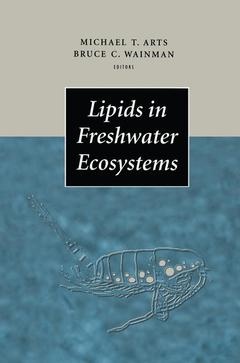Lipids in Freshwater Ecosystems, 1999
Langue : Anglais

Although limnology is a young discipline, it has, over the past century, experi enced marked growth. Its early descriptive period was a long one, given the enormous diversity of biota and environments in freshwater ecosystems. With the development of quantitative techniques came the ability to measure production rates and other parameters and to demonstrate the effects of nutrient limitation and predation on productivity and energy flow. As understanding of these phenomena grew, so too did our appreciation of the many complex chemical interactions among the biotic and habitat components of freshwater ecosystems. A recent, exciting phase of limnology, which may be called biochemical lim nology, is evolving rapidly. One of its many facets is the study of population and community dynamics at basic physiological levels. Examples are many. The integration of recent studies of food biochemistry with traditional studies of food quantity has begun to reveal the striking importance of food quality to reproduc tion and to the growth dynamics of many aquatic animals. Positive as well as negative alleleochemical interactions, already known in terrestrial ecosystems, are emerging as a major factor of many competitive interactions in fresh waters.
1. Determination of Total Lipid, Lipid Classes, and Fatty Acids in Aquatic Samples.- 1.1. Introduction.- 1.2. Results and Discussion.- 1.3. Conclusion.- References.- 2. Fatty Acids as Trophic and Chemical Markers in Freshwater Ecosystems.- 2.1. Introduction.- 2.2. Nomenclature.- 2.3. Characteristics of Fatty Acid Markers for Trophic Studies.- 2.4. Primary Sources and Trophic Transfer of Fatty Acids.- 2.5. Research Needs.- 2.6. Conclusions.- References.- 3. Irradiance and Lipid Production in Natural Algal Populations.- 3.1. Introduction.- 3.2. Metabolism and Reallocation.- 3.3. Irradiance and Lipid Synthesis.- 3.4. Conclusions.- 3.5. Research Directions.- References.- 4. Lipids in Freshwater Zooplankton: Selected Ecological and Physiological Aspects.- 4.1. Introduction.- 4.2. Usefulness of Areal Energy Reserve Estimates.- 4.3. Time Course of Lipid Deposition/Loss.- 4.4. Lipids as Indices of Stress.- 4.5. Ultraviolet Radiation and Zooplankton Lipids.- 4.6. Research Needs and Suggested Future Directions.- 4.7. Conclusions.- References.- 5. Lipid Dietary Dependencies in Zooplankton.- 5.1. Introduction.- 5.2. Methods.- 5.3. Results.- 5.4. Discussion.- References.- 6. Seasonal Dynamics of Lipids in Freshwater Benthic Invertebrates.- 6.1. Introduction.- 6.2. Results and Discussion.- 6.3. Research Needs.- 6.4. Conclusions.- References.- 7. Ecological Role of Lipids in the Health and Success of Fish Populations.- 7.1. Introduction.- 7.2. Results and Discussion.- References.- 8. Lipids and Essential Fatty Acids in Aquatic Food Webs: What Can Freshwater Ecologists Learn from Mariculture?.- 8.1. Introduction.- 8.2. Results and Discussion.- 8.3. Concluding Remarks.- References.- 9. Influence of Lipids on the Bioaccumulation and Trophic Transfer of Organic Contaminants in Aquatic Organisms.- 9.1. Introduction.- 9.2. Prediction of Bioconcentration and Bioaccumulation.- 9.3. Factors Affecting Prediction.- 9.4. Mimicking Bioconcentration with Semipermeable Membrane Devices.- 9.5. Toxicity and the Role of Lipid.- 9.6. Relevance of Food Chain Transfer to Bioaccumulation.- 9.7. Biomagnification and Organism Lipids.- 9.8. Lipids and Transgenerational Transfer of Contaminants.- 9.9. Conclusions.- References.- 10. Lipids in Water-Surface Microlayers and Foams.- 10.1. Introduction.- 10.2. Basic Physicochemistry of Surface Microlayers.- 10.3. Basic Structure of Foams.- 10.4. Sampling Techniques.- 10.5. Physicochemical Processes at the Surface Microlayers.- 10.6. Lipids in the Water-Surface Microlayers and Foams.- 10.7. Research Needs.- 10.8. Final Remarks.- References.- 11. Comparison of Lipids in Marine and Freshwater Organisms.- 11.1. Introduction.- 11.2. Discussion.- 11.3. Conclusions.- References.
Ouvrage de 319 p.
15.5x23.5 cm
Thèmes de Lipids in Freshwater Ecosystems :
© 2024 LAVOISIER S.A.S.
